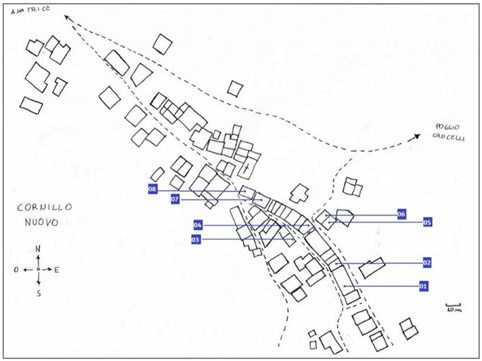Abstract
The contribution of this article is that it provides indications for the conservation of the surviving architecture in the Amatrice area, which was severely affected by the long seismic sequence between 2016 and 2017. The traditional construction technique was carefully studied during the safety works that were carried out in the villages from 2018 to 2020. From the studies conducted, it emerged that most of the historical building fabrics date to a post-seismic reconstruction phase of the seventeenth–eighteenth century. The masonry construction technique found on the site is homogeneous throughout the area and is based on the use of local sandstone and raw earth mortars. The mineralogical nature of the materials used for building was identified by means of specific diagnostic analyses as well as the production processes of the materials. An interpretation of the use of different materials and processes was provided by cross-referencing the analytical results with the existing data on the seismic history and on the geographical and geological characteristics of the territory; additionally, an interpretation of the development of the local historical construction techniques was provided as well. Defining conservation strategies for buildings that are still recoverable is an important objective that is aimed at safeguarding the material evidence of the local construction tradition. The same conservation strategies could be pre-emptively adopted in similar rural contexts.
1. Introduction
Between 2016 and 2017, an extreme series of earthquakes hit central Italy. The first mainshock occurred on August the twenty fourth, 2016; the epicentre was localized nearby Amatrice, a small historical city in northern Lazio. The aftershocks came in succession up to January 2017, and the most intense aftershock occurred nearby Norcia (Umbria) on October the thirtieth 2016, considerably increasing the damage [1]. The entire earthquake sequence involved a wide territory, including four different regions: Lazio, Umbria, Abruzzo, and Marche. Among the more than one hundred historical city centres severely damaged, Amatrice, hit since the first mainshock, had the worst balance; the current study has focused on this territory. The need to urgently study the local building tradition to increase knowledge and to provide a documentation of the conservative conditions of the historical fabrics immediately became clear. The historical urban fabric was not well-known until the earthquake, except for architectural excellences such as churches and palaces. It was therefore considered important to develop an analysis procedure as it is necessary for the study of historic buildings. In fact, in recent years, scientific research has shown that in the many cases where the historical evolution of architecture is not known, it is important to establish a precise and repeatable analysis procedure for an in-depth knowledge of the built heritage [2]. The focus of this research has been oriented on ordinary historical residential and rural buildings. To conduct this research, it was necessary to project and carry out a program of emergency studies to know and document local historical building traditions. The conditions of collapse or severe damage have been converted into opportunities of a fast examination of the structures and building techniques (Figure 1, Figure 2 and Figure 3).
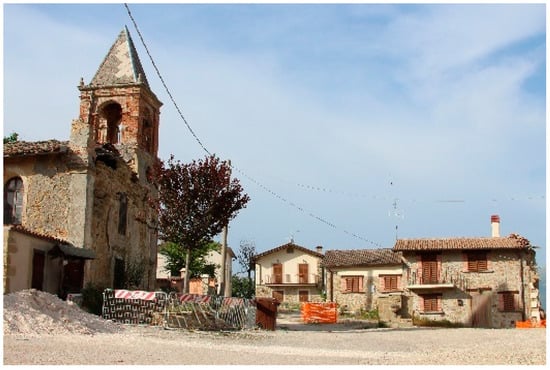
Figure 1.
Piazza di Collegentilesco, a hamlet of Amatrice (RI). Author photo.
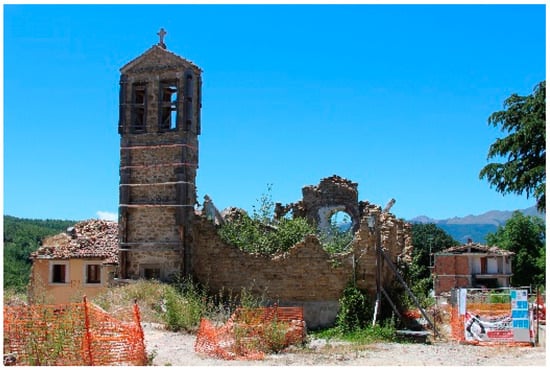
Figure 2.
Remains of the church of San Clemente in Retrosi, a hamlet of Amatrice (RI). Author photo.
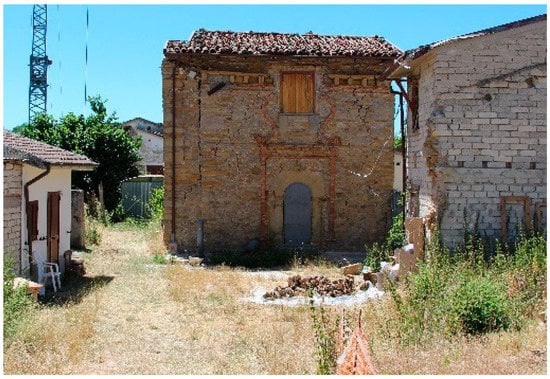
Figure 3.
Palazzetto Ruggeri in Moletano, a hamlet of Amatrice (RI). Author photo.
It emerges from the research that the local building tradition is totally connected to the available materials in the territory. Over time, a masonry technique based on the exclusive use of local stone and raw earth mortars has been developed. The use of raw earth as a building material, often in rural settings, is well-documented by the scientific literature [3,4,5,6]. The aspects that are much less known are the mixed construction techniques, such as the one detected, which are based on the use of stone and raw earth mortars [7].The knowledge base currently available for the materials involved in the local construction technique makes it possible to conduct further studies on their response to seismic stresses, as has been performed in other cases [7,8], so as to be able to evaluate their vulnerability and consolidate them [9]. The research results could be very useful for future conservation and reconstructive actions in the Amatrice territory and could also suggest the development of investigation and conservation strategies for other similar contexts.
2. Materials and Methods
The research was conducted in an emergency context. The investigations were conducted in Amatrice and in ten selected hamlets1. At the time of the on-site investigation, the historic centres had been evacuated and bounded. The only ones who could access the vicinity were firefighters, civil protection, and teams of experts for the survey of seismic damage2. In order to conduct the studies on the local building tradition in safety, it was necessary to project a method that would allow for data to be collected effectively and quickly without hindering the routine operations of the survey of damages and safety interventions that were being conducted on the structures. We proceeded by developing the work in two distinct phases. The first phase was an operational phase based on exploratory inspections, data collection, and sampling of material to be analytically studied. The second phase was carried out in several university laboratories, where the analyses of sampled materials were performed: characterization in optical microscopy, microanalytical tests for the detection of CaCO3 in mortars, petrographic characterization of thin sections of mortars, and analysis of materials in XRD and SEM + EDS3.
2.1. Phase I: Inspection, Data Collection and Sampling
The organization of the inspections was based on prior knowledge of the urban structure and the pre- and post-earthquake conditions of the historic centres. A historical and urban planning study of Amatrice and its hamlets was therefore carried out in advance, which was also performed through the use of graphic and photographic documentation dating back to shortly before the earthquake. We then proceeded by projecting forms for the on-site data collection. The data collection forms have been conceived as an attachment of the already existing schedographic tools used for the survey of post-seismic damage according to the Italian legislation in force (AeDES)4. This on-site editable document has been called the “Materic-Diagnostic Attachement” (AMD) to AeDES form. Creating a document that was directly connected to those produced in standard practice was useful for the speed of data collection, integration with other information on the building structures normally examined following an earthquake, and sharing of knowledge. The AMD is dedicated to the in-depth knowledge of materials, local construction techniques, and the state of conservation of the ordinary historical building heritage. The compilation of the AMD and the damage detection activities conducted by the civil defence is simultaneously conducted. In this way, it is possible to provide an overall assessment of the extent of the seismic damage that is also in relation to the previous degradation, which in turn is dependent or not dependent on the traditional construction techniques. The AMD also allows users to compile a part relating to preliminary general indications on any diagnostic investigations, with a vision oriented towards the conservation of ordinary historical buildings affected by seismic events. The AMD forms were extensively compiled on all ordinary buildings in the accessible areas of the historical centres chosen for this research. In this way, it was finally possible to gather enough information to document the material and technical characteristics of the historical building fabric (Appendix A, Table A1, Table A2 and Table A3). The study of the building techniques was based on a direct observation of the walls in the elevation. The sections of walls that had collapsed were also directly studied. The identification of the lithotypes and the study of the morphology and processing of the stone wall elements were related to the research in the territory of the supply sites of raw materials: quarries and natural deposits. Stone samples from the masonry and quarry sites were taken, compared, and analysed in the laboratory (Appendix B and Appendix C). An analytical characterization campaign was also conducted for the bedding mortars of the masonry and for the residues of traditional plasters that were still present on many buildings.
2.2. Phase II: Analytical Characterization of Materials
During the on-site survey campaign, the resistance of the bedding mortars was estimated by means of a campaign of on-site penetrometric measurements5 (Table 1). Samples of bedding mortars and traditional plaster were collected (Appendix D and Appendix E). Samples of lithic materials from the masonry of the buildings and samples from quarries and natural deposits were also collected (Appendix B and Appendix C). In fact, it seemed appropriate to compare the characteristics of the lithic materials used in the masonry with those of the lithotypes available in the area to investigate how the possible selection of materials took place in the historical constructive tradition. In total, 16 samples were selected for diagnostics, 8 mortars and 8 lithic materials (Table 2 and Table 3). The code assigned to each sample was derived from the mapping of the buildings, which was carried out during the on-site inspections. Any location that was inspected was coded using the capital initial letter (Capricchia = C, Cornillo Nuovo = C.N., etc.) and mapped, where we assigned each building a capital letter of the alphabet, as can be seen in the figure below (Figure 4).

Table 1.
Resistance of the mortar to penetration measurements (RPM).

Table 2.
List of mortar samples (actually used for the diagnostic investigations)6.

Table 3.
List of lithic samples.
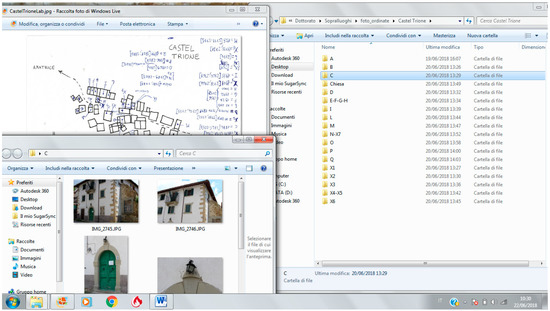
Figure 4.
Summary image of the data processing process and archiving of photographic images taken during the inspections.
The materials were analysed using optic microscopy (optic stereo-microscopy Euromex 10-70X, cross-section; Zeiss Axioskop 40 polarizing microscope, thin section). The lime content in the two types of mortar was verified by means of micro-analytical assays. The mineralogical components of the building materials were identified by an XRD analysis (Bruker D5000 Diffractometer, CuKα radiation, at 40 kV and 40 mA, step size 0.02° for 2 s, powder sample). Other characteristics of the traditional plasters were investigated by SEM imaging (Zeiss Gemini 500 SEM).
3. Results
3.1. The Traditional Building Technique
Most of the masonry analysed were determined to be made up of lithic elements of local sandstone bonded with raw earth. Based on the masonry cataloguing criteria included in the AeDES forms, the wall textures fall within the case study defined as “irregular and of bad quality”. This does not mean that the walls are completely chaotic, but they are not made up of regular elements arranged in perfectly horizontal rows. In fact, in almost all of the buildings with exposed masonry, the stone elements have little to no work performed at all, presenting uneven dimensions. However, there is a good attention to the arrangement of the stone elements in order to respect some horizontal line of the rows. This construction technique has certainly developed as a result of making the most of the territorial resources and natural conditions of the available materials [10]. In fact, the fracture planes of the local sandstone, which emerge in benches throughout the territory, indicate that this type of stone tends to naturally detach in blocks of rather regular shape (Figure 5 and Figure 6).
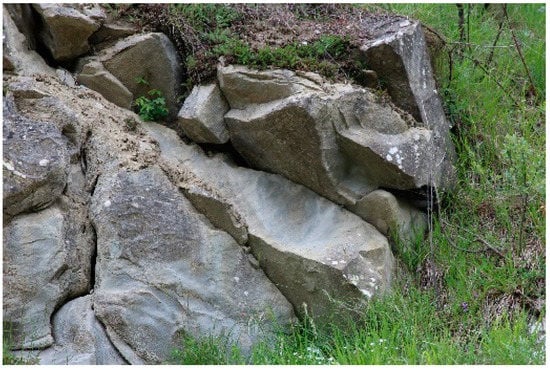
Figure 5.
Sandstone layers in banks; outcrop near Preta, a hamlet of Amatrice (RI). Author photo.
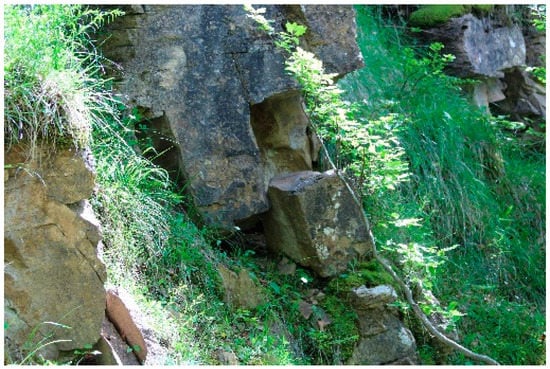
Figure 6.
Sandstone outcrop in banks on the slopes of Monte Gorzano, Amatrice (RI). Detachment of material along the natural fracture planes. Author photo.
The use of the local lithotype has therefore made it possible to build walls which, although not made of square blocks, respect a fair regularity of the textures (Figure 7).
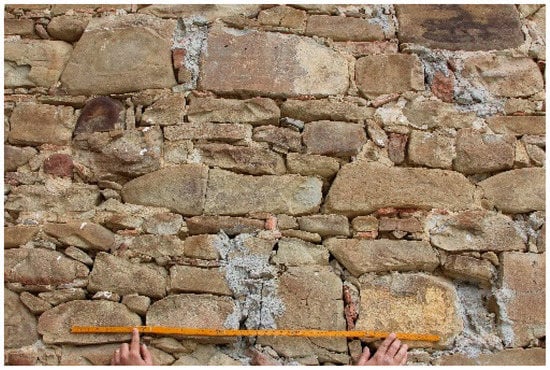
Figure 7.
Typical wall texture of a historic building in the territory of Amatrice. Author photo, Cornillo Nuovo, Amatrice (RI).
The alignments of the rows were also managed using another material available in the area, namely flysch. Flysch is a deposit of marly sandstone that detaches very easily from the substrate in the form of very regular plates with parallel and orthogonal breaking planes according to their typical laminar structure (Figure 8). This lithotype was used in the masonry to regularize the wall equipment by creating horizontal support surfaces for the sandstone blocks. However, there is no lack of more irregular stone elements with a rounded shape. The territory is in fact characterized by a complex network of water resources, mostly in a torrential regime, whose action transforms the arenaceous lithotype into a pebble formation (Figure 9). The use of pebbles was found in the upper parts of the walls and inside the wall cores as filling. The latter data were recorded by analysing the wall sections that were made inspectable due to the numerous collapses; the walls are almost always made up of two similar vestments and a core filled with flakes of stone, pebbles and raw earth. In all of the cases analysed, the presence of connecting headers between the wall leaves was recorded (Figure 10). The walls were covered with protective layers of plaster. In fact, in many of the buildings with exposed or partially exposed masonry, remains of thin plaster were found. (Figure 11). From the visual analysis, the plaster appeared to be created from lime. The diagnostic investigations have thus confirmed the use of lime as a binder.
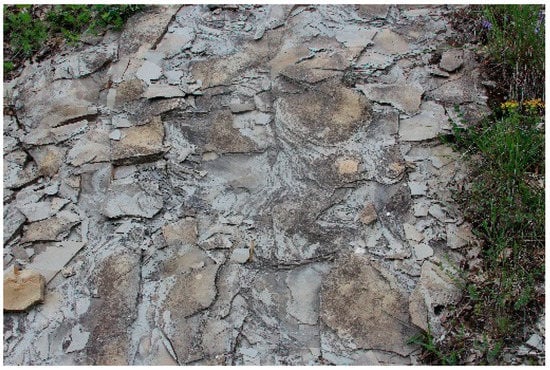
Figure 8.
Flysch outcrop near Preta, a hamlet of Amatrice (RI). Author photo.
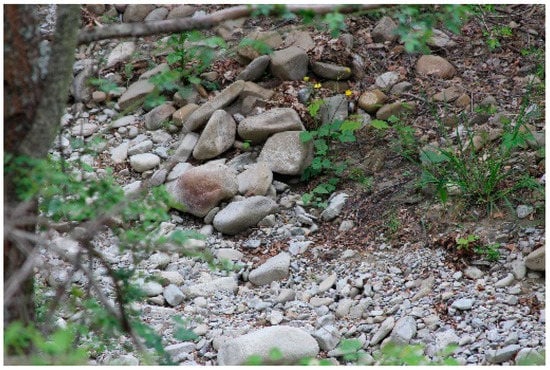
Figure 9.
Deposit of sandstone in pebbles at the Ortanza Waterfall, Amatrice (RI). Author photo.
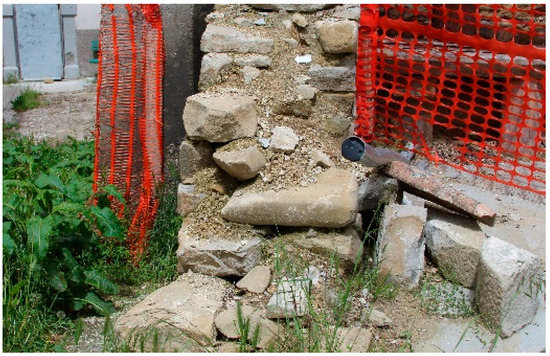
Figure 10.
Wall section exposed following a collapse in Cornillo Nuovo, a hamlet of Amatrice (RI). Author photo.
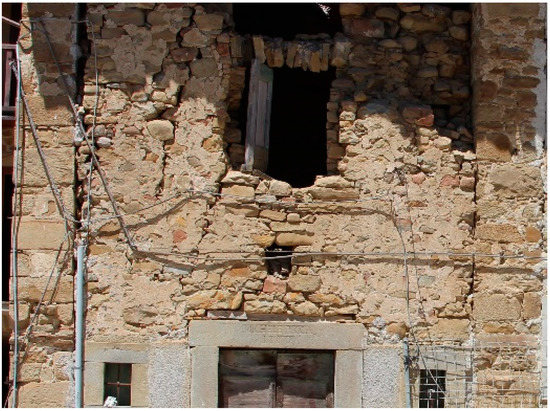
Figure 11.
Building with traces of traditional plaster in Collecreta, a hamlet of Amatrice (RI). author Photo.
3.2. Results of Diagnostic Investigations on Masonry Binding Mortars
The resistance of the bedding mortars was estimated by means of penetrometric tests carried out in situ on eight historic buildings in Cornillo Nuovo, a hamlet of Amatrice8. Resistance values between 0.8 and 2.3 MPa were recorded, which are well below the minimum quality requirements normally accepted9 (Table 1). From the results of the diagnostic campaign, the historical binding mortars are composed of pressed raw earth. Optical microscopy investigations revealed a composition of a clayey binder and sandy aggregate, which was also mineralogically characterized by means of XRD analysis. The very fine grain size of the aggregates and the apparent absence of sieving suggests a direct use of the land available on-site without special processing. The results of the XRD analyses also highlighted the close connection between the mineralogical components of the arenaceous lithotypes emerging in the area and those of the binding mortars. The minerals identified are the same except for two exceptions: in the raw earth mortars, there is the presence of sanidine, which is not significantly present in the sandstones, and the absence of calcite and dolomite, which are instead minority components of the local sandstones. These data confirm the hypothesis of the use of raw earth taken from the soil. The soil, in fact, arises from the degradation of the mother rock, in this case from the claying of the sandstone. This phenomenon is very slow and is caused by mechanical, physical, and chemical processes. Among the chemical transformation processes, there is the dissolution of calcite and dolomite, which are generally decomposed before other silicate minerals. At the same time, the chemical alteration of some of the albite components of the sandstones can produce newly formed minerals such as sanidine [11] (Table 4).

Table 4.
Comparative analysis of the minerals detected by XRD between lithic samples and mortars.
3.3. Results of Diagnostic Investigations on Plasters
The plasters were made up of a binder based on air lime and sandy aggregate. The binder showed cooking defects, which manifested themselves through the presence of large and numerous calcinelli10. The observation using optical microscopy showed a good sieving of the aggregates and the intentional and systematic addition of vegetable fibres. This finding attests to a good tradition acquired in the processing of mortars for plasters. The XRD investigations on the mineralogical species confirmed the local and natural origin of the sands used as aggregates. The SEM investigations provided information on the good adhesion capacity of the binder to the vegetable fibres, which confirms the intentional choice of the addition, evidently aimed at avoiding shrinkage cracks and ensuring good adhesion of the plaster to the substrate. The substantial difference between the composition and processing of mortars for plaster and structural mortars for masonry is surprising, first of all for the use of air lime as a binder, and then for the well-structured use of vegetable fibres.
4. Discussion
The presence of air lime in the plasters and, at the same time, the total absence of this binder in the mortars of the masonry, can raise some questions about the reasons or the contemporaneity of the work. The mortar samples analysed were taken from historic buildings, which is presumably attributable to the post-seismic reconstruction phase following the devastating earthquakes that occurred from 1639 to 1703 [12]. The reuse of stone materials to rebuild the walls is quite plausible, whereas the exclusive use of raw earth in the walls is reasonably due to the scarce presence of limestone suitable for producing lime in the area. This post-seismic reconstruction also took place in a particularly depressed historical period from an economic point of view, in which the use of raw earth was also encouraged by building manuals in both Italy and in Europe [13,14]. If we consider, as can be assumed, that the mortars for the plasters are contemporary with the structural ones, it can be assumed that the builders were aware of the intrinsic fragility of masonry being bound with only raw earth. The differences found would derive from this awareness: the presence of lime, the careful sieving of the aggregates, and the conscious addition of fibrous vegetable materials. In fact, these walls, if well-protected by a layer of good plaster, could still ensure the stability and durability of the building as long as periodic maintenance of the structures was guaranteed, even with the possible replacement of damaged parts. Therefore, the lime produced with the few suitable raw materials available in the area was consciously reserved to produce plaster mortars, which acted as a protective material for the underlying walls.
5. Conclusions
By re-elaborating the analytical results in light of the existing data on the seismic history and on the geographical and geological characteristics of the territory, an interpretation was provided on the use of the different materials available and on the resulting processing in the different types of mortars; furthermore, a general interpretation of the development of traditional building techniques in the Amatrice area was provided. What emerges is the extraordinary ability of local communities to make the most of available resources. The lithological homogeneity (with very little presence of limestone suitable for the production of lime), the geographical isolation, the rural character of the villages, and the agricultural and pastoral vocation of the territory are factors that jointly contributed to the development of the peculiar and rather atypical building traditions at the national level. The traditional and rural architectural heritage that survived in the villages in the aftermath of the extensive destruction caused by the earthquake is configured as the bearer of deeply identifying historical values of the places affected. It is therefore necessary to propose appropriate conservation strategies in view of the next phase of the restoration and reconstruction of the villages and for the future of this territory. The first strategic action that should be introduced is that of scheduled maintenance. The vulnerability of earthen architecture is well-known, as are the techniques for its consolidation. However, the historical architecture of the Amatrice area does not directly fall into this series, as the buildings are built using a sort of mixed technique that uses stone and raw earth. Therefore, we hope for future insights and research with the aim of conducting conservative actions that could also be only based on the scheduled maintenance and reproduction of traditional building techniques, which is an approach that has proven to be a winning approach for earthen architecture [15]. Such conservation actions should systematically include the goal of the seismic improvement of buildings [7,9]. It should not be forgotten that the studied realities insist on a territory with a very high seismic risk, and these data cannot be neglected in the conservation strategies. Numerous factors contribute to the stability of the buildings; among these factors, one of the most important is the masonry quality. The direct observations of the buildings have shown that despite almost all of the walls having been built using little to no worked lithic material, those that have shown greater resistance to the earthquake show a certain care in the juxtaposition of the elements, the particular attention that has been paid to the realization of horizontal elements and regularizations in the facing, the technical measures that have been conducted in the corner solutions and insertion of connecting headers between external and internal facing, and the use of traditional anti-seismic devices, such as wooden radiciamenti11. These traditional constructive characteristics express a probable awareness of the seismic risk on the part of the populations that have historically settled in the territory and must be respected and understood for the purposes of creating adequate and compatible seismic improvement planning for the structures. The phase of restoring and reconstructing the affected territories must develop in parallel with incentive strategies for the repopulation of the villages. The repopulation, however, must be accompanied by campaigns to raise awareness of the conservation of historical building traditions. In fact, it should be considered that many of the small towns affected by the earthquake had already suffered a considerable depopulation and, consequently, a lack of maintenance for many of the buildings [16]. On the other hand, the buildings still inhabited before the earthquake were in many cases renovated but in an improper way, for example, with the reconstruction of floors and reinforced concrete roofs. The latter proved to be too rigid and heavy and were unable to ensure the stability of the buildings. The sum of all of these intrinsic frailties has led to a considerable level of damage to the centres affected by earthquakes, to which has been added the impossibility of preserving much of the urban fabric from demolition. It is therefore necessary to reflect on the advisability of intervening in advance in other centres where similar characteristics are found in the building tradition; in this sense, the areas for consideration in Italy are, for example, those of Campidano in Sardinia, where there are numerous historical testimonies of rural architecture in raw earth. However, above all, other areas where the seismic risk is greater must also be considered. In the Modena area, for example, though the seismic risk was not among the highest, the effects of the earthquake that struck Emilia-Romagna in 2012 were felt; in examples of rural architecture that were studied, and even in some cases of the nobler architecture, the construction methods were found to be based on the use of bricks and raw earth [14]. In southern Italy, the use of raw earth as a binder for the lithic elements in the walls of historic buildings has been studied in some areas of Basilicata and in the historic centre of Lamezia (Calabria) [17]. Those regions present a very high seismic risk. To prevent what happened in Amatrice, detailed studies on building techniques and historical materials should be immediately launched and maintenance plans should be implemented that mainly provide for the protection of the masonry built using raw earth while excluding the overlapping of reinforced concrete elements. These criteria should be applied on a global scale in all cases where there are historical testimonies of raw earth architecture or mixed techniques such as the one represented by this study where there is also a condition of high seismic risk.
Funding
This research received no external funding.
Institutional Review Board Statement
Not applicable.
Informed Consent Statement
Not applicable.
Data Availability Statement
The author’s doctoral thesis, on which all the details of the study are published, is available on the IRIS uniroma1 database: https://iris.uniroma1.it/handle/11573/1461744 (accessed on 1 February 2023).
Acknowledgments
Arrizza Lorenzo, Conte Aida, Corda Laura, De Cesaris Fabrizio, Fiorani Donatella, Giorgi Elisabetta, Mannetta Domenico, and Santarelli Maria Laura.
Conflicts of Interest
The author declares no conflict of interest.
Appendix A

| SECTION 1_BASIC CONDITIONS: AeDES FORM DATA | |||||
| Building age | Construction: | ▣ < 1919 | Renovation: | No | |
| STRUCTURAL DAMAGES | ▣ Intermediate/Serious | ◻ Slight | ◻ No damage | ||
| USABILITY RESULTS | ◻Temporally unusable | ◻ Partially unusable | ◻ To be reviewed | ▣ Unusable | ◻ Unusable for external risks |
| SECTION 2_MATERIC DATA | |||||

Table A1.
Masonry: “irregular and of bad quality” texture ▣.
Table A1.
Masonry: “irregular and of bad quality” texture ▣.
| Lithic Elements | ① Non Processed Stone Elements | ② Pebbles | ③ Bricks | ④ Other Elements | |||
|---|---|---|---|---|---|---|---|
| Mortars | |||||||
| ⑤ Traditional ◻ In a good state of conservation ▣ In a bad state of conservation | ▣ | ▣ | ▣ | ▣ | |||
| ⑥ Recent grouting ◻ In a good state of conservation ▣ In a bad state of conservation | ▣ | ▣ | ▣ | ▣ | |||
| Decay | Joints Erosion | ⑦ Lithic Element’s Decay | Lack of Lithic Elements | ||||
| Extension E | |||||||
| E > 75% | ▣ | ◻ | ◻ | ||||
| NOTES: | |||||||
| ① Local sandstone | |||||||
| ② Sandstone pebbles used to fill gaps between other irregular lithic elements. | |||||||
| ③ Brick fragments used to fill gaps between other irregular lithic elements. | |||||||
| ④ Flysch laminar fragments used to create horizontal support surfaces for the sandstone blocks. | |||||||
| ⑤ Raw earth binding mortars. | |||||||
| ⑥ Cementitious grouting made to fill the eroded joints. | |||||||
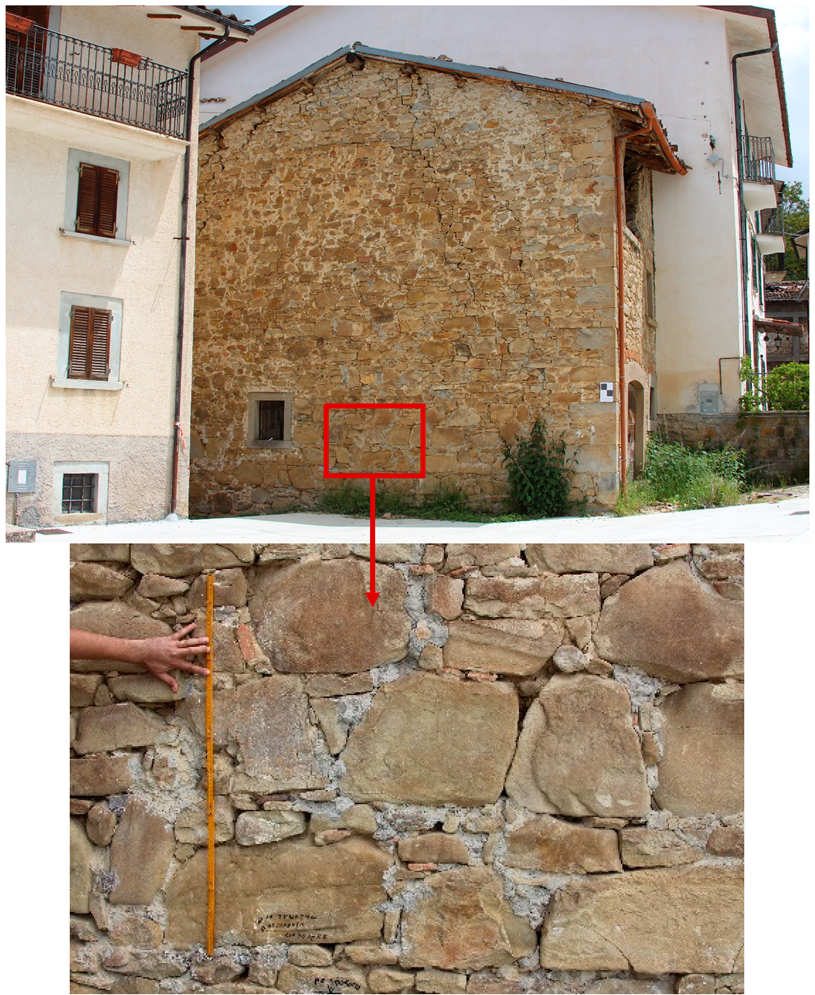 | |||||||

Table A2.
Wooden structures ▣.
Table A2.
Wooden structures ▣.
| Decay | ① Degraded Elements | Missing Elements | |||
|---|---|---|---|---|---|
| Structural Typology | |||||
| Main beams | ◻ | ◻ | |||
| Secondary beams | ▣ | ▣ | |||
| Extent | ▣ 10–50% | ◻ 50–75% | ◻>75% | ||
| NOTES: | |||||
| ① Biodeteriogen attacks, fungal attacks | |||||
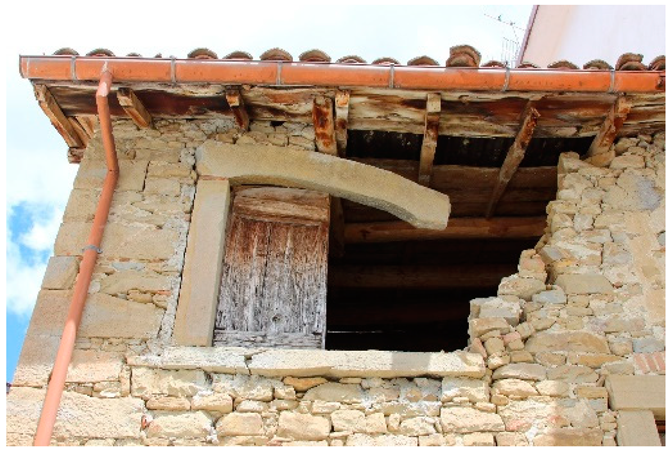 | |||||

Table A3.
Notable elements ▣.
Table A3.
Notable elements ▣.
| ▣Corner structures | Made with carved blocks of local sandstone |
| ▣Frames | Windows frames: simple frames in local sandstone (partially collapsed). |
| ▣Portals | Very simple portal in local sandstone with a segmental arch. |
| ▣Decorative elements/Other type of elements | Flat arches made with bricks over the portal and the windows. |
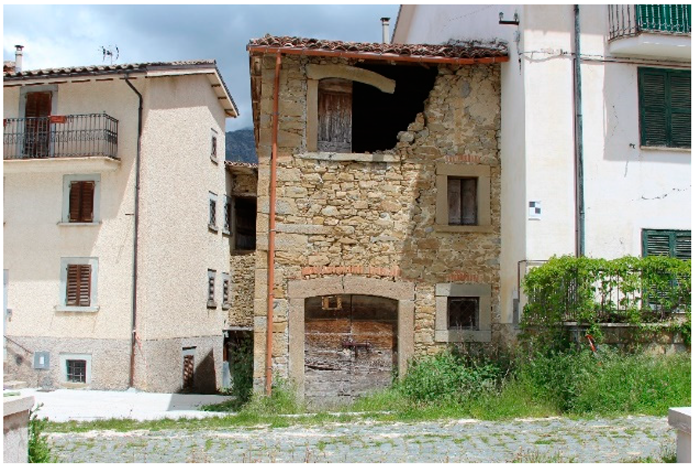 | |
| SECTION 3_REQUIREMENTS FOR DIAGNOSTIC INVESTIGATIONS |
| Structural tests/diagnostic investigation |
| Already prescribed demolitions or removals (AeDES form) Prescribed materials sampled for the characterization of binding mortars probably made with raw earth. |
Appendix B. Sampling Sheet (Lithic Materials from Building)
| Sample Code | Location | Municipality | Material |
| C.N.A. | Cornillo Nuovo | Amatrice | Sandstone |
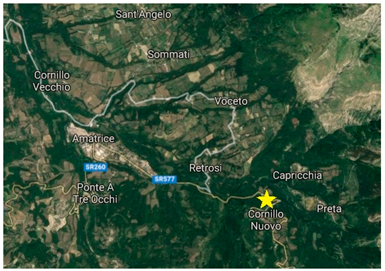 | 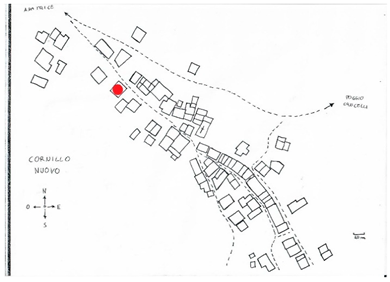 | ||
| Cornillo Nuovo GPS coordinates: 42°61′42.5″ N 13°33′21.2″ E Altitude 1134 m.a.s.l. | Building A GPS coordinates: 42°61′45.3″ N 13°33′12.6″ E | ||
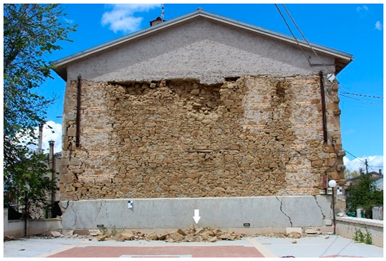 | 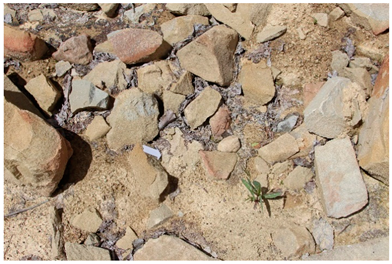 | ||
Building description and sampling area
| Sampling details
| ||
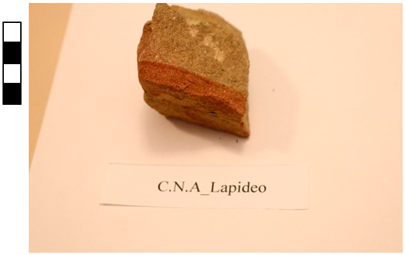 | 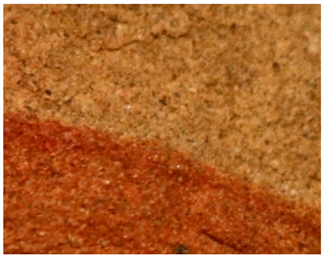 | ||
| Sandstone sample. Double-colour sand and red, probable presence of iron oxides. | Double coloration detail. | ||
Appendix C. Sampling Sheet (Lithic Material from Natural Field)
| Sample Code | Location | Municipality | Material |
| P.C.O.01 | Preta (Ortanza Falls) | Amatrice | Flysch |
 | 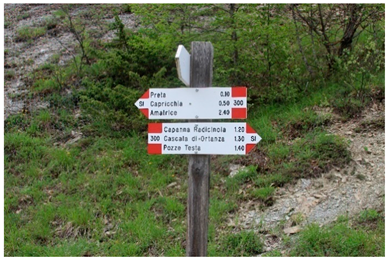 | ||
| Preta GPS coordinates: 42°61′68.4″ N 13°34′56.9″ E Altitude 1194 m.a.s.l. | Ortanza Falls path GPS coordinates: 42°60′84.2″ N 13°35′00.6″ E | ||
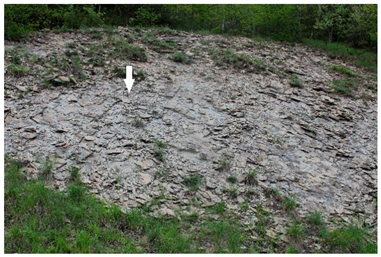 | 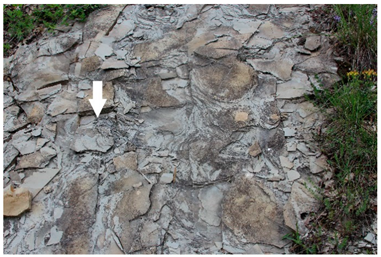 | ||
| Sampling area | Sampling details The Flysch splits according to orthogonal fracture lines. | ||
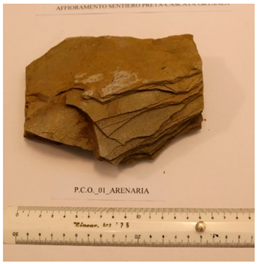 | 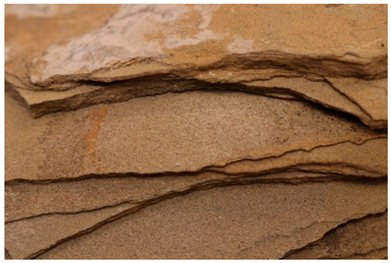 | ||
| Flysh sample: laminar and layered. | Layered structure detail. | ||
Appendix D. Sampling Sheet (Binding Mortar)
| Sample Code | Location | Municipality | Material |
| C.I.01 | Capricchia | Amatrice | Binding mortar |
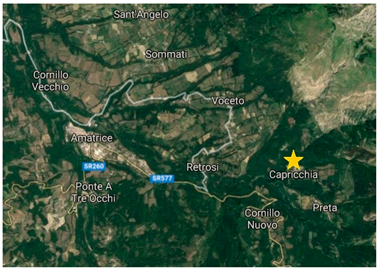 | 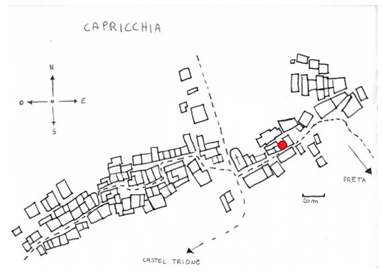 | ||
| Capricchia GPS coordinates: 42°37′21.6″ N 13°20′23.7″ E Altitude 1106 m.a.s.l. | Building I GPS coordinates: 42°62′25.7″ N 13°31′10″ E | ||
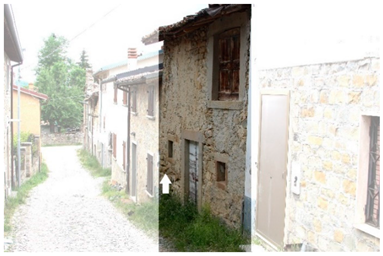 |  | ||
Building description and sampling area
| Sampling details
| ||
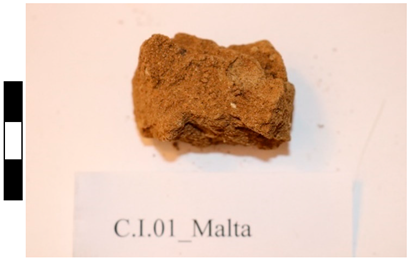 | 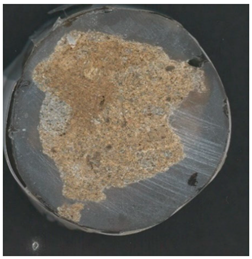 | ||
| Binding mortar sample, breakable, wet, tending to crumble. Colour: umber. | Cross-section made by incorporating the sample in cyanacrylate resin and cutting with a Remet miter saw with a circular diamond blade at AStRe Lab Mat. Tablet diameter 3 cm. | ||
Appendix E. Sampling Sheet (Plaster)
| Sample Code | Location | Municipality | Material |
| C.I.02 | Capricchia | Amatrice | Plaster mortar |
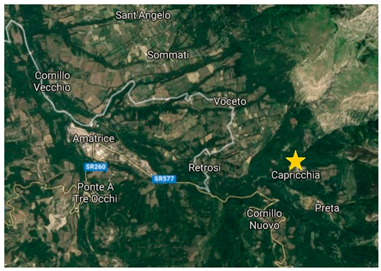 | 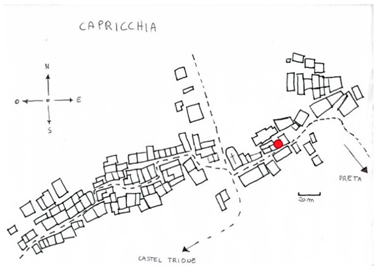 | ||
| Capricchia GPS coordinates: 42°37′21.6″ N 13°20′23.7″ E Altitude 1106 m.a.s.l. | Building I GPS coordinates: 42°62′25.7″ N 13°31′10″ E | ||
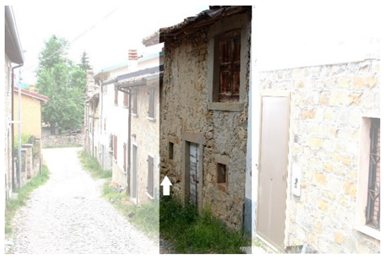 | 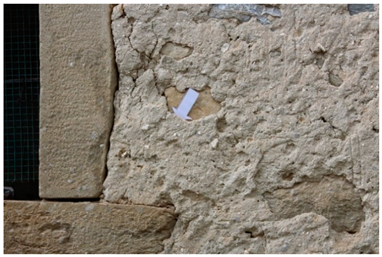 | ||
Building descripiom and sampling area
| Sampling details
| ||
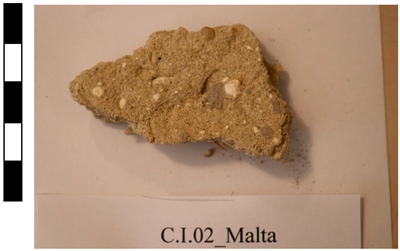 | 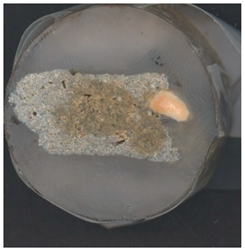 | ||
| Plaster sample: frail, tending to crumble. Colour: beige/gray. Visible calcinelli. Visible vegetal fragments. | Cross-section made by incorporating the sample in cyanacrylate resin and cutting with Remet miter saw with circular diamond blade at AStRe Lab Mat. Tablet diameter 3 cm. | ||
Notes
| 1 | The hamlets investigated are Capricchia, Cascello, Castel Trione, Collecreta, Collegentilesco, Cornillo Nuovo, Moletano, Prato, Preta, Retrosi and Scai. The selection was made from 78 hamlets belonging to the municipality of Amatrice. The selection criteria were mainly three: presence of historic urbanizations; historically existing links between villages on which a homogeneous traffic of resources can be assumed, including construction materials; intermediate levels of post-seismic damage in order to allow safe inspection activities. |
| 2 | The inspections were conducted from April to July 2018 in safe conditions through specific agreements with the UCCR Lazio. |
| 3 | Stereo-microscopy analysis, cross section, AStRe LabMat, Department of History, Design and Conservation of Architecture, Sapienza University of Rome. Microanalytical assays for the detection of CaCO3, AStRe LabMat, Department of History, Design and Restoration of Architecture, Sapienza University of Rome. Analysis in petrographic optical microscopy, thin section. Thin sections laboratory, Department of Earth Sciences, Sapienza University of Rome. XRD Analysis, XRD Laboratory, Department of Earth Sciences, Sapienza University of Rome. SEM analysis, Microscopy Center, University of L’Aquila. |
| 4 | AeDES Form, Usability and Damage in Seismic Emergency, prepared by the Department of Civil Protection of the Presidency of the Council of Ministers, is a form for the rapid detection of damage, the definition of emergency measures and the evaluation of post-seismic practicability of buildings of ordinary structural type. |
| 5 | Mechanical penetrometer for mortars RSM 15, DRC Srl; AStRe LabMat, Department of History, Design and Restoration of Architecture, Sapienza University of Rome. |
| 6 | The mortar samples taken were a total of 14, but only 8 of them were suitable for incorporation for observation in light microscopy, preliminary analysis to all the others of the laboratory diagnostic campaign. |
| 7 | The C.N.A. sample has been photographed and documented together with the mortar samples. Despite being a lithic sample, it is the only one taken from the rubble of a building and not in surfacing mode, so it was decided to combine its documentation with that of the mortar samples, as a material ‘in place’ in the building. |
| 8 | For reasons related to the management of the seismic emergency such as changes in the perimeter of the red areas and related access permits, it was not possible to perform penetrometric tests and sampling for laboratory investigations on the same buildings. However, it was considered appropriate to perform these tests in order to estimate the resistance of the bedding mortar used for the urban fabric. |
| 9 | The minimum strength value prescribed by the Technical Construction Standards (NTC 2018) is 2.5 MPa. Mortars can therefore be accepted as sufficiently resistant if they reveal an estimate of their resistance equal to or greater than this value in the penetrometric test. For values above 5 MPa, the mortar can be considered very resistant. |
| 10 | Calcinelli are lumps of quicklime, sometimes easily recognizable even with the naked eye, due to their typical circular shape, their very bright white colour and their grainy, sometimes dusty consistency. Their presence can depend on various errors in the processing of lime. A calcinelli-free mortar is certainly made using an excellent quality binder. A preponderant presence of these formations in the binder fraction of the mortar denotes a poor quality of the binder with serious consequences on the strength and durability of the mortar itself. |
| 11 | The wooden radiciamenti are traditional anti-seismic safeguards in the area of central Italy which consist of inserting small beams suitably oriented and drowned in the masonry in the points of greatest weakness. |
References
- ISTAT. Caratteristiche dei Territori Colpiti dal Sisma del 24 Agosto 2016. Available online: https://www.istat.it/it/files//2016/09/Focus-sisma-15sett2016.pdf (accessed on 23 August 2019).
- Pucello, I.; Karwacka, E. The Importance of an Integrated Historical Analysis for the Preservation of Cultural Heritage Monumental Buildings: The Case Study of Certosa Di Calci. Int. J. Archit. Herit. 2022, 1–29. [Google Scholar] [CrossRef]
- Achenza, M.; Cocco, C. A web map for Italian earthen architecture. In Earthen Architecture: Past, Present and Future, Proceedings of the International Conference on Vernacular Heritage, Sustainability and Earthen Architecture, Valencia, Spain, 11–13 September 2014; Mileto, C., Vegas, F., Soriano, L.G., Cristini, V., Eds.; Taylor & Francis Group: London, UK, 2015; pp. 11–16. [Google Scholar]
- Fratini, F.; Rescic, S.; Riminesi, C.; Mattone, M.; Rovero, L.; Tonietti, U. The vernacular earthen architecture near Turin (Piedmont, Italy). In Earthen Architecture: Past, Present and Future, Proceedings of the International Conference on Vernacular Heritage, Sustainability and Earthen Architecture, Valencia, Spain, 11–13 September 2014; Mileto, C., Vegas, F., Soriano, L.G., Cristini, V., Eds.; Taylor & Francis Group: London, UK, 2015; pp. 145–150. [Google Scholar]
- Guillaud, H.; Moriset, S.; Gandreau, D. Continuity of French rammed earth architecture. In Earthen Architecture: Past, Present and Future, Proceedings of the International Conference on Vernacular Heritage, Sustainability and Earthen Architecture, Valencia, Spain, 11–13 September 2014; Mileto, C., Vegas, F., Soriano, L.G., Cristini, V., Eds.; Taylor & Francis Group: London, UK, 2015; pp. 3–10. [Google Scholar]
- Di Pasquale, L.; Mecca, S. Earthen Architecture in Italy; In Terra Europae; ETS: Princeton, NJ, USA, 2011. [Google Scholar]
- Gallego, R.; Arto, I. Evaluation of seismic behaviour of rammed earth structures. In Earthen Architecture: Past, Present and Future, Proceedings of the International Conference on Vernacular Heritage, Sustainability and Earthen Architecture, Valencia, Spain, 11–13 September 2014; Mileto, C., Vegas, F., Soriano, L.G., Cristini, V., Eds.; Taylor & Francis Group: London, UK, 2015; pp. 151–156. [Google Scholar]
- Hernández, I. Earthen architecture’s on seismic areas: Costa Rica’s case. In Earthen Architecture: Past, Present and Future, Proceedings of the International Conference on Vernacular Heritage, Sustainability and Earthen Architecture, Valencia, Spain, 11–13 September 2014; Mileto, C., Vegas, F., Soriano, L.G., Cristini, V., Eds.; Taylor & Francis Group: London, UK, 2015; pp. 187–192. [Google Scholar]
- Cantagallo, C.; Spacone, E.; Perrucci, D.; Liguori, N.; Verazzo, C. A Multilevel Approach for the Cultural Heritage Vulnerability and Strengthening: Application to the Melfi Castle. Buildings 2020, 10, 158. [Google Scholar] [CrossRef]
- Comin-Chiaramonti, P.; Mazzucchelli, M. Elementi di Petrografia Applicata. Plinius 2017, 43, 150–324. [Google Scholar]
- Castelli, V.; Camassi, R. The shadow-zone of large italian earthquakes. Early journalistic sources and their perception of 17th–18th Centuries seismicity. J. Earthq. Eng. 2005, 9, 333–348. [Google Scholar] [CrossRef]
- Rondelet, J.F. Traitè Theorique et Pratique de L’art de Bâtir; Didor, Parigi: Paris, France, 1812. [Google Scholar]
- Gilly, D. Handbuch der Landbaukunst; Vieweg: Berlin, Germany, 1797. [Google Scholar]
- Del Rosso, G. Dell’economica Costruzione delle Case di Terra—Opuscolo Diretto Agl’industriosi Possidentie Abitatori Dell’agro Toscano; Presso J.A. Bouchard: Firenze, Italy, 1793. [Google Scholar]
- Achenza, M.; Sanna, U. Il Manuale Tematico Della Terra Cruda; DEI tipografia del Genio Civile: Roma, Italy, 2009. [Google Scholar]
- Gruppo di Lavoro INGV sul Terremoto in Centro Italia. Relazione Sullo Stato Delle Conoscenze Sulla Sequenza Sismica in Centro Italia 2016–2017 (Aggiornamento al 2 Febbraio 2017); Gruppo di Lavoro INGV sul Terremoto in centro Italia: Rome, Italy, 2017. [Google Scholar] [CrossRef]
- Proto, N.; Cicione, F. L’edilizia di tradizione rurale nella conformazione delle aree urbane lametine. In Forum UNESCO, 1th International Research Seminar on Architectural Heritage and Sustainable Development of Small and Medium; Cities in South Mediterranean Regions: Florence, Italy, 2004. [Google Scholar]
Disclaimer/Publisher’s Note: The statements, opinions and data contained in all publications are solely those of the individual author(s) and contributor(s) and not of MDPI and/or the editor(s). MDPI and/or the editor(s) disclaim responsibility for any injury to people or property resulting from any ideas, methods, instructions or products referred to in the content. |
© 2023 by the author. Licensee MDPI, Basel, Switzerland. This article is an open access article distributed under the terms and conditions of the Creative Commons Attribution (CC BY) license (https://creativecommons.org/licenses/by/4.0/).
